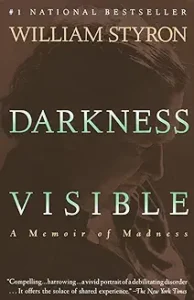Darkness Visible: A Memoir of Madness by William Styron 1990
In this intensely personal and painful memoir, Styron, who won both the National Book Award and the Pulitzer for his fiction, shares his experience with severe depression. Struggling with this ‘darkness’ since early adulthood, the feelings of anxiety, hopelessness, exhaustion, and sadness become overwhelming during a visit to Paris in 1985. Leaving Paris precipitously, he returns to NYC and the care of a psychiatrist, pseudonymously referred to as Dr. Gold. As anti-depressant after anti-depressant medication fails to help him, Styron actively contemplates suicide before he is hospitalized. The hospital with its ‘green walls’ and sterile atmosphere saves his life with the quiet and solitude that this sanctuary provides, and Styron eventually returns to his life of writing.
I found this book to be vaguely disappointing. Perhaps its because, as Styron himself writes in several pages of the book, it’s impossible to convey the depth of the pain felt by someone with severe depression. My disappointment may also have been fueled by Styron’s repeated efforts to share his understanding of the science and medicine involved in this disorder. The combination of pseudo-science and his description of the unbearable pain just didn’t work for me.
The most interesting part of the book was his exploration of suicide as a positive gesture, a taking charge of one’s life. At one point, Styron lists the many writers and creatives who ended their own life including Hart Crane, Vincent van Gogh, Virginia Woolf, Arshile Gorky, Cesare Pavese, Romain Gary, Vachel Lindsay, Sylvia Plath, Henry de Montherlat, Mark Rothko, John Berryman, Jack London, Ernest Hemingway, William Inge, Diane Arbus, Tadeusz Borowski, Paul Celan, Anne Sexton, Sergei Esenin, and Vlaimir Mayakovsky before ending with “the list goes on”. He dwells at greater length on the suicide deaths of Abbie Hoffman and Primo Levi. This is a rather startling compilation of sadness and tragedy and also an interesting sequence with no discernible pattern of chronology, discipline or even alphabetical order.
Styron spends considerable time on Albert Camus’ work, finding the French writer’s alienation from the world amidst the paradox of a beautiful world and a finite, pain-filled lifespan. While Camus didn’t commit suicide he did die young in a car crash.
Styron, confronted with intolerable pain that appeared to have no end or relief, decides to kill himself, contemplating the beams in the attic or the trees in his farmhouse yard, kitchen knives, the warm bath to receive the flow from his arteries, and other methods. He even destroys a notebook that had served as a sort of diary for years, but when it came time to write his suicide note he wavers. When he forces himself to watch a movie and hears Brahms’ Alto Rhapsody, he is reminded of the great beauty in the world and decides he cannot ‘commit this desecration’ on himself and those so close to him.
This is a slim volume definitely worth reading if you are a therapist and also worth reading, I would guess, if you struggle with dark demons.



